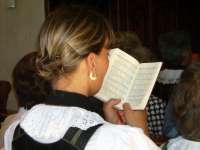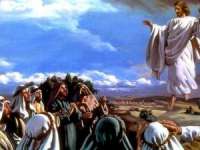
The Holy Shroud
From the studies of
Mons. Giulio Ricci,
Shroud researcher

The very same time that, under the Catholic faith, Christ spent in the sepulchre before resurrection. The linen shrouded the body, in which living and post-mortem blood were still present: already coagulated blood the first, and partly the second.
Following the biochemical laws about blood coagulation and of fibrinolysis, it is possible today to speculate if the morphology of the blood, detectable on the Holy Shroud, follow the coagulation laws and if the approximately 36 hours of contact of the fabric with the body were sufficient to verify the fibrinolysis phenomenon, under the specific environmental circumstances.
That evidence cannot be the creation of a hypothetical falsifier, because the coagulation phenomenon and the following impression on the linen are not reproducible by brush.
Here they are the spots of living blood and coagulated how they appear on the Shroud in the authentic pictures:
The fibrin has marked around the margins of the blood spot a thicker edge, while inside the spot the plasma is more faded, as it has to be: as to the post-mortem blood, marked on the Shroud in the thoracic gouge and the flow of it in and around the kidneys and partially in the soles, this is an exsiccated blood that follows the morphology of the blood of a dead body, coagulated earlier and that, shows the clots surrounded by the serum liquid, in contrast to what happens to the living blood.
The Holy Shroud shows all the evidence of the fibrinolysis phenomenon.
This phenomenon follows strictly some laws, related to the period of contact, only after a certain determined period of time the impression on the linen is possible. With a different period is likely to observe different results: with a shorter period the impression is not possible, with a longer period the impression is stained and ruined by an excessive softening of the fibrina. This process is documented (2).
The linen shrouding the naked and wounded dead body of the Man of the Shroud testifies that the fibrinolysis process was stopped, as the spots are typical spots of living blood coagulated or post-mortem exsiccated blood, perfectly marked in their specific morphology.
The first experiments were realized by Mignon. Recently new discovers about the liquefaction of the blood clots under specific conditions can help shedding light on the problem. Balck writes: «The fibrinolysis phenomenon in subjects submitted to wild stress is now well documented. The clots formed on the skin ante-mortem can easily undergo fibrinolysis after the death for the action of the fibrinolytic fabric or for the action of the bacteria. The softened clots can be absorbed by the linen, and experiments can be undertaken to determine their morphology (Dott. D. Willis in «Did He die on the Cross?» - If this process didnt come to the end, a valid reason should have interrupted it. There are two hypotheses:
1 - the body was stolen after being left the shroud aside;
2 - the body, after that determined period of time, was detached by the shroud by its own, leaving the science to the XX century the task to reveal the secret in it: a secret that can be connected with the biggest mystery of the human history: the Resurrection of Christ.
The first hypothesis was backed by the judges of the Sanhedrin and it was never supported by the first authentic witnesses of the Resurrection of Christ and by the first apostolic and under-apostolic traditions. The linen, found well folded at dawn of the Sunday by Peter and John, should trace back to the stealing of a body again naked! This was simply inconceivable for the mentality of the Jews at that time, it was legally impure everyone who had just touched a linen in which a dead body was buried(3), and it was against the Roman law that punished with death those who desecrated a sepulchre(4). In this case the biochemical exam of the fibrinolysis should confirm that the thieves should have tear away the linen from the body of the Shroud after a determined period of time in which the linen had been in contact with the body.
(3) «Qui tetigerit immundum super mortuo, immundus usque ad vesperum» (Lev. 22,4-6).
(4) In this case the thieves of the sepulchre should have been the same «friends» of Jesus, as the judges of the Sanhedrin said. But at that moment the Friends hadnt any idea of Jesus being resurrected. It was just after the many apparitions of Jesus (2 in the Cenacle, at closed doors, one on the lake and so on.) that they were confirmed in the faith and made this historical event, checked by themselves, the central nucleus of their predication and the foundation of the Church. From the same apparitions they understood the nature of the glorious body of Christ.
The theft would have been a too risky and dangerous enterprise for the goal of instilling the idea of resurrection, at a time when the same thieves were not still aware of it. None of Jesus disciples was hold as breakers of that sepulchre, well kept by the Temples guards, who would have not hesitated to report to the Sanhedrin the brave (!) breakers whose intent would have been to take off the heavy stone with iron bars, sealed to the same stoned hill where the grave was dug.
The courage of the Disciples before and after the Passion of the Rabbi, is well depicted in the Gospel (Jh. 20,19 - Mt. 26,56 - Mc. 14,50).
The soldiers presence at the sepulchre that Saturday evening and till Sunday is documented by the Evangelists. If the theft took place, this should have happened before the seal of the stone, that is to say in the Saturday evening before sunset. But this would have been impossible as the soldiers checked the sepulchre before sealing it.
The short period of time between the sealing (Saturday evening) and the resurrection (Sunday at dawn, few hours later) excludes any sort of negligence by the soldiers in the custody of the Holy Sepulchre and the theft of the body.
After the escape of the frightened soldiers the judges of the Sanhedrin invented that account, otherwise they would have to conclude that the body had been stolen with the sealed stone still at its place and under the soldiers of the Temple eyes...!
A second hypothesis considers a possible negligence by the Sanhedrims side (event almost unthinkable): they would have not checked the dead body presence before sealing the stone, the same stone already prepared the Friday evening by Joseph of Arimathea, the owner of the sepulchre. In this way the theft would have took place during the Shabbat rest (!) or at the end of it, at the Saturday sunset, at the very same time in which the judges of the Sanhedrin were negotiating with Pilate about the guards to place in front of the sepulchre.
In both cases, the time of contact between the linen and the body have to be reduced. The fibrinolysis would be able to certify that reduction of contact with the Shroud. Always considering as trustworthy the event that the thieves had lost time in leaving aside and folding the shroud, while running the serious and incumbent risk of being tremendously punished if caught, as Eusebius and the first Fathers testify.
The last hypothesis considers is that of the theft of the body with the Shroud; in that case the various areas of the Shroud touching the wounds would have suffered severe consequences and they would have been partially detached, this would have been interrupted the fibrinolysis process as in the first case or the period of contact would have been prolonged and the spots would have been damaged by the contact with the linen, and this is to be excluded in the Shroud of Turin.
Even the hypothesis of a secret and inaccessible burial place for Jesus as it was for Moses, is unable to answer tall he questions. This hypothesis was articulated by the Jewish theology and considered also recently with the discovery of the bones of John of Ezekiel.
All those arguments about the theft of Jesus body by the Disciples (and by them secretly buried) dodnt touch the authenticity of the Shroud that had to follow the event occurred to the body.
John testifies against this hypothesis and he says that the burial linens were found well folded and far away from the shroud (also well folded) on the burial stone, at dawn of Sunday of resurrection. No other shroud is possible as the Evangelists and the patristic tradition give evidence.
The Shroud is still there with its unmistakable image of photographic negative. Only the modern biochemical science has discovered some characteristics unrepeatable by brush. Only recently some experiments have demonstrate how some colours red-mauves have been possible thanks to the presence of aloe and myrrh on the fabric, while usually the blood on the fabric lost its colour to turn a pale sepia; the shroud is there with its spots perfected by some chemical reagents (like aloine) that bring to surface from that linen the moving image of a man sentenced to death by crucifixion with cloves, who has suffered under a typical cruel flagellation, an unusual crowning with thorns, hit by a spear into the right thoracic cavity, in order to check his death, all this instead of a typical crucifixion, and who is remained with the face bent even in the sepulchre, as it was only for the Jesus of the Gospels.
The image of the face is really particular: its renaissance beauty, revealed for the first time from a photographic-ray, in 1898, was not conceivable to be realized by brush by a painter, in a period before the invention of the photography. All this is a proof, written by the bloody letters, on that burial linen that shrouded for 36 hours the body of the Man of the Shroud; proof that is linked directly and validly, to the only miracle, the most incredible, made by Jesus for His own following His affirmation:
"17 Therefore doth my Father love me, because I lay down my life, that I might take it again. 18 No man taketh it from me, but I lay it down of myself. I have power to lay it down, and I have power to take it again. This commandment have I received of my Father. (Jh.10,17-18)


















 +
+



